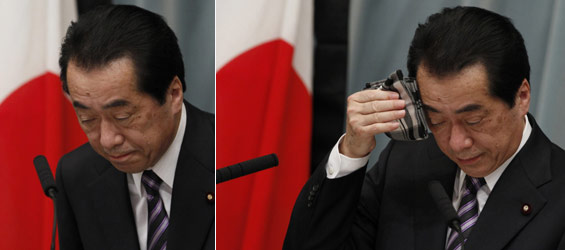TOKYO, April 1 (Xinhua) — Prime Minister Naoto Kan said on Friday that he would do everything in his power to ensure that Japan overcomes its worst crisis since World War II.
Speaking at a nationally televised news conference, Kan said that the fight to bring the nuclear crisis in Fukushima Prefecture under control would be a long one but he remained convinced that Japan would pull through.
“I am prepared for a long-term battle over the Fukushima nuclear plant and to win this battle,” the prime minister said.
“We cannot say that the plant has been sufficiently stabilized, but we are preparing for all kinds of situations and I am convinced that the plant can be stabilized,” he added.
Kan played down potential health risks caused by the radiation-leaking Fukushima Daiichi nuclear power plant, whose critical cooling systems failed after being pounded by a massive tsunami.

“As long as government advisories were adhered to, people’s health wouldn’t be compromised,” he said. “In Japan, we ask people to follow the rules because if they do, there will be no damage to their health.”
The prime minister also said that the government would decide whether to expand the evacuation zone from 20-km around the volatile facility based on advise from nuclear experts.
The International Atomic Energy Agency (IAEA) had urged Japan to widen the evacuation zone around the stricken plant and evacuate people out of the village of Iitate, 40 km northwest of the facility, on concerns of elevated levels of radiation found in air, soil and sea samples in the area.
But Kan said that evacuation advice from its own nuclear safety agency as well as global watchdogs was being heeded.
“Japan decides on the area of evacuation around the plant based on experts’ advice and proposals,” the prime minister said.
Kan’s comments came despite the government’s Nuclear and Industry safety Agency saying that radioactive water may be freely flowing into the Pacific Ocean through drainage systems and supply trenches.
On the future of the beleaguered utility firm, and amid rumors of nationalization, Kan said that he wanted Tokyo Electric Power Co. (TEPCO) to redouble its efforts as a private entity, but added that ultimately the government would take responsibility for the massive compensation claims.
“If it exceeds TEPCO’s capabilities, the government must deal with the issue responsibly,” he said.
But while Kan said that an extra budget would be compiled to deal with the monumental affects of the disaster and some state-projects for this fiscal year have already been suspended. He failed to explain exactly where the cash-strapped government would get the emergency allocation.
According to Economy Minister Kaoru Yosano, the total cost of the disaster would range between 191 to 298 billion U.S. dollars.
As the government struggles with a budget deficit equal to nearly 50 percent of the government’s pre-quake budget, economists fear the government may struggle to issue further debt to effectively deal with the crisis.
Meanwhile, thousands of Japanese Self-Defense Forces (SDF) personnel and U.S. military troops on Friday launched a massive mission to find and retrieve bodies that had not yet been recovered.
The search came as the government revealed that radiation from a nuclear power plant crippled by the twin disaster had been found in groundwater, with contamination already reported in the air, ocean and food.
Some 8,000 SDF personnel and about 7,000 U.S. military troops will take part in the intensive search and recovery operation, the defense ministry said.
Japanese and U.S. troops deployed 120 aircraft and 65 vessels to be used in the three-day mission to search coastal areas where homes, businesses, schools, ships and cars were swept away by massive torrents of water following the earthquake.
The National Police Agency said on Friday that the catastrophic earthquake and ensuing tsunami have so far left 11,620 people dead and 16,464 others missing.
Many victims of the quake and ensuing tsunami are believed to have been swept out to sea by the surging tsunami and the huge recovery operation has been launched to coincide with favorable tidal patterns that will make it easier to detect bodies, the ministry said.
Local police in Fukushima Prefecture believed that more than 1, 000 bodies still remain uncollected within the evacuation zone around the volatile nuclear plant and are being exposed to increasing levels of radiation day-by-day as they decompose.









